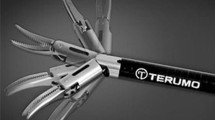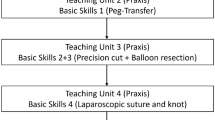Abstract
Background
Laparoscopic instruments are rigid and thus cannot provide the degrees of freedom (DOF) needed by a surgeon in certain situations. A new generation of laparoscopic instruments with the ability to articulate their end effectors is available. Although these instruments offer the flexibility needed to perform complex tasks in a constricted surgical site, their control may be hampered by their increased complexity.
Methods
This study compared the task performance between articulating and conventional laparoscopic instruments. Surgeons with extensive laparoscopic experience (8 experts) and staff with no surgical experience (8 novices) were recruited for the test. Both groups were required to perform three standardized tasks (peg transfer, left-to-right suturing, and up-and-down suturing) in a bench top model using conventional and articulating instruments. Performance was scored using a standardized 100-point scale based on movement speed and accuracy. After the initial trials with conventional and articulating instruments, each participant was given a short orientation on how to use the articulating instrument advantageously. The participant then was retested with the articulating instrument.
Results
As expected, the expert group scored significantly better than the novice group (p < 0.001). The combined data from both groups showed better performance with the conventional instruments than with the articulating instruments (p = 0.074). The experts maintained their proficient laparoscopic performance using conventional instruments in their first attempts with the articulating instruments (91 vs. 84), whereas the novices had greater difficulty with the articulating instruments than with the conventional instruments (46 vs. 59). After a short orientation, however, the novices outscored the expert group in terms of net improvement in performance with the articulating instrument (27 vs. 1% improvement).
Conclusion
Experienced surgeons are readily able to transfer their skills from conventional to articulating laparoscopic instruments. To speed the learning process, the use of articulating instruments can be started at an early stage of surgical training.






Similar content being viewed by others
References
Haluck RS, Satava RM, Fried G et al (2007) Establishing a simulation center for surgical skills: what to do and how to do it. Surg Endosc 21:1223–1232
Satava RM (2007) The future of sugical simulation and surgical robotics. Bull Am Coll Surg 92:13–19
den Boer KT, de Jong T, Dankelman J, Gouma DJ (2001) Problems with laparoscopic instruments: opinions of experts. J Laparoendosc Adv Surg Tech A 11:149–155
Bann S, Khan M, Hernandez J et al (2003) Robotics in surgery. J Am Coll Surg 196:784–795
Berguer R, Smith W (2006) An ergonomic comparison of robotic and laparoscopic technique: the influence of surgeon experience and task complexity. J Surg Res 134:87–92
Zheng B, MacKenzie CL (2007) The control strategy for degrees of freedom in remote prehension with a tool. In: HFES (ed) Proceeding of the 52nd human factors and ergonomics society annual meeting, Baltimore, Maryland on Human Factors/Ergonmics, pp 61–62
Derossis AM, Fried GM, Abrahamowicz M, Sigman HH, Barkun JS, Meakins JL (1998) Development of a model for training and evaluation of laparoscopic skills. Am J Surg 175:482–487
Feldman LS, Sherman V, Fried GM (2004) Using simulators to assess laparoscopic competence: ready for widespread use? Surgery 135:28–42
Swanstrom LL, Fried GM, Hoffman K, Soper NJ (2005) Beta rest results of a new system assessing competence in laparoscopic surgery. J Am Coll Surg 202:62–69
Acknowledgment
We thank Cambridge Endoscopic Devices, Inc. for supporting the device in the data collection of this study.
Author information
Authors and Affiliations
Corresponding author
Rights and permissions
About this article
Cite this article
Martinec, D.V., Gatta, P., Zheng, B. et al. The trade-off between flexibility and maneuverability: task performance with articulating laparoscopic instruments. Surg Endosc 23, 2697–2701 (2009). https://doi.org/10.1007/s00464-009-0462-y
Received:
Revised:
Accepted:
Published:
Issue Date:
DOI: https://doi.org/10.1007/s00464-009-0462-y




